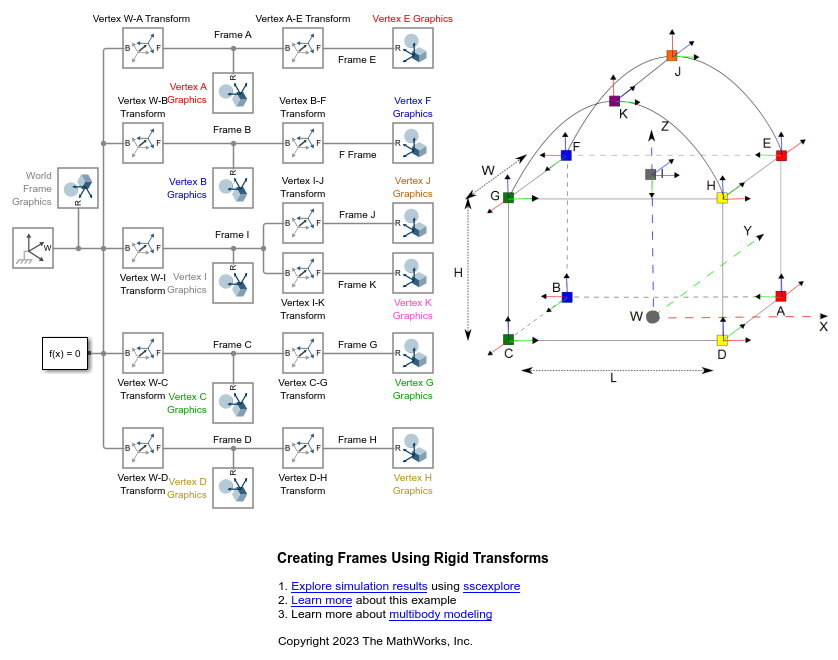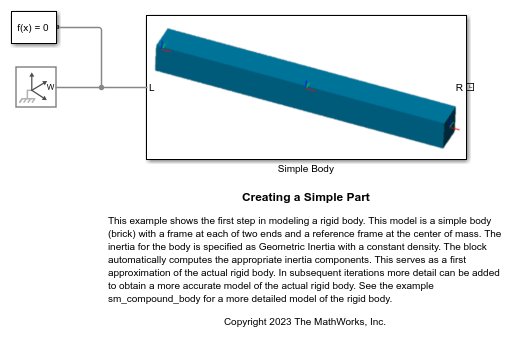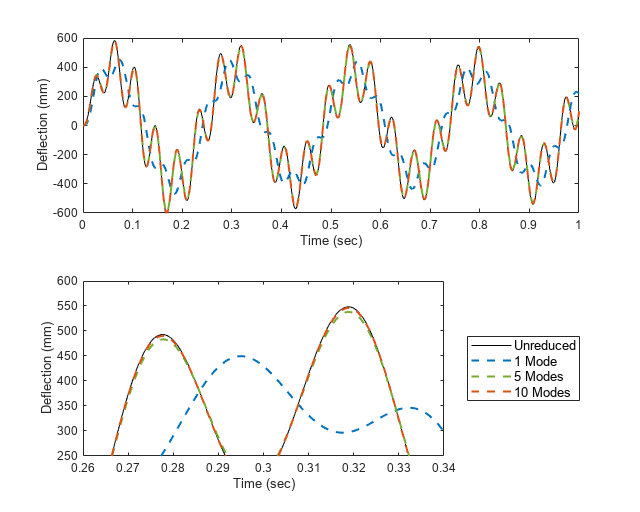바디
관절 기계 어셈블리의 바디를 모델링합니다. 바디는 강체 또는 유연체일 수 있으며, 유연체는 힘이나 토크가 작용할 때 자유롭게 변형될 수 있습니다. 모든 바디는 기하, 관성, 색 등의 물리 속성에 의해 정의됩니다. 유연체는 강성, 감쇠, 이산화 수준과 같은 추가적인 속성도 가집니다.
강체는 다양한 솔리드 블록과 File Solid 블록을 기반으로 하며, 특수한 경우에는 가변 질량 블록과 기하 블록을 기반으로 합니다. 이러한 블록은 Body Elements > Variable Mass 라이브러리에서 찾을 수 있습니다. 3차원 부품 파일에서 바디를 가져오려면 File Solid 블록을 사용하십시오. 유연체는 Body Elements > Flexible Bodies 라이브러리의 블록을 기반으로 합니다. 여기에는 단면이 지정된 가느다란 바디를 나타내는 빔 형태의 유연체 블록과, 차수 축소 모델을 통해 변형 가능한 바디의 기계적 동작을 캡처하는 Reduced Order Flexible Solid block 블록이 포함됩니다.
하나의 Brick Solid 블록, File Solid 블록 또는 General Flexible Beam 블록만으로 바디 전체를 모델링할 수 있습니다. 하지만 대개 여러 개의 블록이 필요합니다. 이 경우 여러 개의 단순 바디 요소가 서로 고정된 복합 바디로 구성됩니다. 블록 간의 프레임 연결 선은 바디 요소 사이에 필요한 강체 연결을 구성합니다. 연결 선에 일반적으로 삽입되는 Rigid Transform 블록은 적절한 조립을 위해 필요한 상대 위치와 방향을 제공합니다.
앱
| 유연체 모델 빌더(Flexible Body Model Builder) | Generate reduced-order model data for flexible bodies (R2023a 이후) |
클래스
Simscape 블록
도움말 항목
바디
- Bodies Workflow
Bodies, the core constituents of a multibody model, comprise body elements, each in turn comprising frames and attributes. Modeling a body is more than adding a block to a model. Here are some general steps to keep in mind when modeling one. - Overview of Flexible Beams
Flexible beams are slender bodies with constant cross-sections that can have linear elastic deformations. Use them when the rigid-body approximation is not valid. Here are some background information to keep in mind when modeling flexible beams. - Compounding Body Elements
A typical body is a collection of solids and other body elements. In this sense, it is a compound unit. Learn how you can use compounding to create complex geometries and inertias from simpler ones. - Model an Excavator Dipper Arm as a Flexible Body
Use the Reduced Order Flexible Solid block to model a deformable body of arbitrary geometry. Start with the CAD geometry of the body, produce a finite-element mesh, and generate reduced-order data to use with the block. - Modeling Bodies
Bodies are representations that you create of physical parts—gears, pistons, levers—for later assembly into multibody systems, a piston engine serving as an example. Here is an introduction to bodies as well as the blocks and tools commonly used to represent one in a model.
기하
- Modeling Extrusions and Revolutions
General Extruded Solid and Revolved Solid blocks are the most versatile of the preset solid shapes. Their cross-sections are custom and set by coordinate matrices that you specify. Here is an introduction to both the shapes and the cross-sections that define them. - Representing Solid Geometry
Geometry is a key attribute of solids and of the bodies they comprise. You can specify the shape and size of a solid using the Solid block. Here is an introduction to the types of shapes that you can specify (or import) using this block.
관성
- Representing Solid Inertia
Inertia quantifies the resistance of a body to changes in motion and is among the most important attributes in a model. Here is an introduction to the types of inertias that you can represent in a model as well as the blocks and parameterizations that you can use to do so. - Specifying Custom Inertias
"Inertia" is a general term often used to mean mass, center of mass, the moments of inertia, and the products of inertia. Learn more about these inertia parameters and how they are defined in the Simscape Multibody environment. - Specifying Variable Inertias
Not all inertias remain constant during simulation. Some can vary and it is often their changing parameters that most matter in a model. Learn more about variable inertias and how you can specify their parameters in a model.
프레임
- Creating Connection Frames
Often, you must create new frames for use in joint and constraint connections. Learn how you can create such frames and how joints and constraints affect their placements in a body. - Creating Custom Solid Frames
All solids have a local reference frame but you can create other, custom, frames, for connection in a model. Learn how you can perform this task using the frame creation panel of the Solid block. - Working with Frames
Frames are axis triads that encode the position and orientation of body elements in a body. Learn about frames as a means to connect body elements and about rigid transforms as a means to offset those elements.
시각화
- Manipulate the Color of a Solid
Color helps to differentiate bodies and contributes to the effectiveness of a multibody visualization. Learn about the color parameters that you can specify and their impact on the appearance of your bodies. - Visualize a Model and Its Components
Visualization is not only a central part of a multibody simulation, but also an essential tool in modeling bodies and verifying their shapes, sizes, frame placements, and colors. Here is an overview of the visualization utilities available in the Simscape Multibody environment and the roles they play in your modeling workflow.




